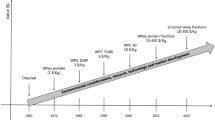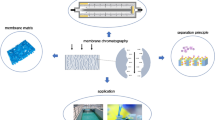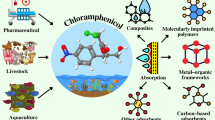Abstract
Leukocytes were separated from whole porcine blood using laboratory prepared polymeric asymmetric porous membranes from cellulose acetate (CA) and by applying standard blood cell separation methods: centrifugation in a Ficoll solution gradient and in sucrose solution concentration gradient. Leukocytes, obtained by different separation methods were characterised by their quantity, type, viability and growth ability. Membranes prepared by a wet phase inversion process from different cellulose acetate/acetone/water and magnesium chlorate VII systems, were characterised according to: permeability to deionised water, surface morphology and by the determination of the flux of the permeate during the whole porcine blood separation. Cellulose acetate membranes prepared from 300 μm thick cast solution (14.8 wt% of cellulose acetate, 19.9 wt% of water, 2.3 wt% of Magnesium perchlorate, and 63.0 wt% of acetone), have separation characteristics comparable with the standard separation methods; in the dead-end mode filtration, 21.3% of leukocytes from porcine whole blood are separated. The leukocyte number in peripheral blood before separation was 450,000 ml-1; the number passed through after was 95,000±6620. The main interest of the study was to introduce the CA membrane filters for the continus technological separation of the leukocyte/lymphocytes from animal (= porcine, bovine, horse..) blood.
Similar content being viewed by others
References
Alberts B, Lewis J, Ralf M, Roberts K and Watson DJ (1989) Molecular biology of the cell. pp. 159-162. Garland Publishing Inc., London and New York.
Almici C, Carlo-Stella C, Donnenberg AD and Rizzoli V (1993) Counterflow centrifugal elutriation: present and future. Bone-Marrow-Transplant. 12(2): 105-108.
Lindl T and Bauer J (1989) Zell und Gewbekultur, pp. 97-99. Gustav Fisher Verlag, London and New York.
Broek AP (1993) Characterization of Hemodialysis membranes: Membrane Structure and Function. PhD Thesis; Twente University, Enschede, The Netherlands.
Boedeker B, Lehmann J, VanDamme J, Kappmeyer H, Gassel WD, Havemann K, Schwulera V, Ruml F and Muhlradt PF (1984) Production of five human lymphokines (granulocytemacrophage colony stimulating factor, interferon-γ, interleukin-2, macrophage cytotoxicity factor and macrophage migration inhibitory factor) from ConA stimulated lymphocyte cultures in bioreactors. Immunobiol 166: 12-23.
Cutts H (1976) Methods utilising differences in specific gravities of cells. In: Cell separation: Methods in hematology, pp. 117-128. Academic Press, London and New York.
Filipič B, Golob A, Sinadinovska R, Babič D, Struna T and Pretnar G (1990) Preparation and purification of porcine immune interferon. In: Likar M (Ed), Conference to the 45th Anniversary of the Institute of Microbiology of the Medical Faculty in Ljubljana, pp. 71-80 (In Slovenian).
Filipič B, Golob A, Struna T and Likar M (1994) Porcine mitogen-induced interferon. Acta Virol 38: 71-75.
Harris ELV and Angal S (1989) Protein purification methods - A practical approach, pp. 80-87. IRL Press, New York.
Hitzler W(1993) Der gegenwartige Stand der Blutfiltration-Grundlagen und klinische Bedeutung von Leukozytendepletions-und Mikroaggregatfiltern bei Bluttransfusion. Anasthesiol Intensivmed Noftallmed Schmerzther 28: 341-351 (in German).
Kim KJ, Fane AG, BenAim R, Liu MG, Jonsson G, Tessaro IC, Broek AP and Bargeman D (1994) A comparative study of techniques used for porous membrane characterisation: pore characterisation. J Membrane Sci 87: 35-46.
Kunst B and Sourirajan S (1970) Evaporation rate and equilibrium phase separation data in relation to casting conditions and performance of porous cellulose acetate reverse osmosis membranes. J Appl Polym Sci 14: 1983-1996.
Kutowy O, Thayer WL and Sourirajan S (1978) High flux cellulose acetate ultrafiltration membranes. Desalination 26: 195-210.
Loeb S and Sourirajan S (1962) Seawater demineralisation by means of an osmotic membrane. Adv Chem Ser 38: 117-132.
Loeb S (1981) The Loeb-Sourirajan membrane: how it came about. In: Turbak AF (Ed) Synthetic membranes, volume I, Desalination, pp. 1-9. American chemical society symposium series 153, Washington D.C.
Manjikian S (1967) Desalination membranes from organic casting solutions. Ind Eng Chem Prod Res Dev 6: 23-32.
Malchesky P (1994) Nonbiological Liver Support: Historic Overview. Artificial Organs. 18(5): 342-347.
Mizrahi A, Lazar A and Reuveny S (1990) Interferons derived from the human cells. In: Animal cell biotechnology, Vol. 4, pp. 413443. Academic Press, London and New York.
Mulder M (1991a) Basic principles of membrane technology, pp. 198-280. Kluwer Academic Publishers, Dordrecht, Boston, London.
Mulder M (1991b) Basic principles of membrane technology, pp. 281-311. Kluwer Academic Publishers, Dordrecht, Boston, London.
Reuvers AJ (1987) Membrane formation; diffusion induced demixing processes in ternary polymeric system. PhD Thesis, Twente University, Enschede, The Netherlands.
Reuvers AJ, vanden Berg JWA and Smolders CA (1987) Formation of membranes by means of immersion precipitation. Part I. A model to describe mass transfer during immersion precipitation. J Membrane Sci 34: 45-65.
Reuvers AJ and Smolders CA (1987) Formations of membranes by means of immersion precipitation. Part II. The mechanism of formation of membranes prepared from the system cellulose acetate/acetone/water. J Membrane Sci 34: 67-86.
Ridge D (1978) Practical aspects of rate-zonal centrifugation. In: Birnie GD and Richwood D (Eds) Centrifugal separations in molecular and cell biology, pp. 219-227. Butterworths, London.
Strathmann H, Scheible P and Baker RW (1971) A rationale for the preparation of Loeb-Sourirajan-type cellulose acetate membranes. J Appl Polym Sci 15: 811-828.
Strathmann H (1992) Economic Assessment of Membrane Processes. In: Li NN and Calo JM (Eds) Separation and Purification Technology, pp. 1-18. Marcel Dekker, Inc. New York, Basel, Hong Kong.
Stropnik Č, Germič L and Žerjal B (1996) Morphology variety and formation mechanisms of polymeric membranes prepared by wet phase inversion. J Appl Polym Sci 61: 1821-1830.
Ward RA, Feldhoff PW and Klein E (1985) Membrane materials for therapeutic application in medicine. In: Lloyd DR (Ed) Material science of synthetic membranes, pp. 99-118. American chemical society symposium series 269, Washington D.C.
Rights and permissions
About this article
Cite this article
Cencič, A., Koren, S., Filipič, B. et al. Porcine blood cell separation by porous cellulose acetate membranes. Cytotechnology 26, 165–171 (1998). https://doi.org/10.1023/A:1007997104501
Issue Date:
DOI: https://doi.org/10.1023/A:1007997104501




